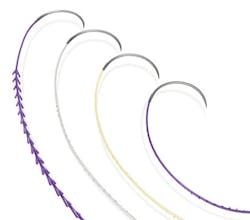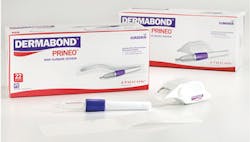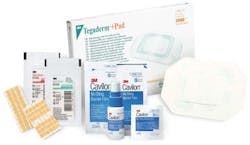Wound care has become increasingly more advanced and precise with a variety of solutions now tailored to the different types of wounds clinicians treat every day. Pressure wounds, surgical incisions, ostomies, diabetic ulcers — you name it, and likely there’s a product available to address specific needs and encourage optimal protection and healing. In other words, advanced wound-care products offer more than just coverage. They can help to speed healing, reduce length of hospital stay, improve patient comfort and safety, help to avoid infection, and, in the long run, save time and money.
At the same time, an important caveat when investigating advanced wound-care products is to ask for the evidence. A recent report from MEDPAGE TODAY noted that “a dizzying array of wound care products has flooded the marketplace in recent years, with untested and unproven claims about their wound healing capabilities.”1 Claims of efficacy should always be backed up by scientific proof that the product is safe and effective for its intended use. White papers can be informative, but published scientific studies verify claims. Don’t be shy about asking for the proof. Vendors will be happy to supply such information.
Weighing the costs
Carolyn Watts
Advanced wound-care products sometimes appear to be more costly at first glance, but when other factors are considered, they can be remarkably cost-efficient. Carolyn Watts, MSN, RN, CWON, President, Wound, Ostomy, and Continence Nurses (WOCN) Society, explained how investing in quality surgical-wound–care products can help to control costs and improve patient outcomes.
“When you use advanced wound-care products, you facilitate faster wound healing by providing the optimal wound environment for healing,” she said. “Also, there are multiple types of dressings that can be used as the wound characteristics change (e.g., change in the amount of drainage). They frequently can stay in place for more than one day, which uses less nursing time. Even though they may cost more when compared to standard gauze dressings, it actually costs less when you look at healing time, minimization of infection, and patient comfort. They can reduce the actual costs by as much as 25 percent to 50 percent or more when used appropriately.”
Complications related to the surgical site can be costly, both in terms of human lives and hospitals’ financial health. Francois Fournier, President, North America AWM, Smith & Nephew, said advanced wound-care solutions designed to ward off adverse events are worth consideration.
“In recent years, healthcare providers have increasingly become aware of the benefits of adopting effective preventive therapies,” said Fournier. “Surgical-site complications have been attracting an increasing amount of attention due to the high economic and, potentially, human cost involved.” He offered a thought-provoking observation: “While surgical techniques evolve rapidly to minimize risk of surgery and improve outcomes, postsurgical-incision–management wound care hasn’t quite evolved in parallel; maybe because it is not yet considered as important as the surgery itself.”
Patrick Parks, MD, PhD, Medical Director, 3M Critical & Chronic Care Solutions Division, agreed and pointed out that postsurgery wounds can be breeding grounds for infection and that investing in quality surgical-wound–care products are necessary for controlling costs and improving patient outcomes.
“These infections can cause serious harm to patients, and treating surgical-site infection can cost up to $29,000 per incident,”2 Parks cautioned. “So, it’s critical to implement best practices and invest in advanced products that offer protection from common infection-causing pathogens that can help provide better patient outcomes and save thousands in added healthcare costs.”
He also noted the robotics movement as a trend in surgical-wound care, explaining the advantage is that it creates less variability in the surgical incision. “The more precise and uniform surgical incisions become, the easier it is to establish a standardized method to treat and heal them.”
Changing patient demographics are another leading factor stimulating product innovation in the postsurgical wound-care category. “Surgical patients are becoming increasingly older and are entering the operating room with more comorbidities, such as obesity, than ever before,” Parks said. “These factors are changing postsurgery care, propelling advances in technology that must accommodate for more diverse patient needs.”
Product characteristics to keep in mind
When selecting wound dressings, Watts suggested facilities choose those “that minimize edema, have an antimicrobial incorporated into the dressing, and can stay in place for several days. There are also short-term, single-use, negative-pressure devices that minimize postoperative complications in specific procedures, an example being total joint replacements. There are also many new biologic dressings that can be used in specific wound types, such as burns or wounds with large tissue deficits, to protect the wound and facilitate faster healing.”
Liza Ovington, PhD, Franchise Medical Director, Ethicon, reminded that, when treating wounds, its best to adopt the tailor-made approach — use the right tool for the right patient. “As we better understand physiology and factors affecting healing, wound-closure technologies have become more innovative and efficient, bringing value to surgeons, patients, and the healthcare system,” she said. “Conditions such as diabetes and high body-mass index are increasingly prevalent and can place patients at increased risk for postsurgical complications, including delayed healing and infection.”
Negative-pressure devices designed to minimize postoperative complications in certain procedures also help clinicians manage surgical wounds successfully while keeping costs down. Fournier talked briefly about the benefits of Smith & Nephew’s negative-pressure wound-therapy devices.
PICO single-use negative-pressure system,
from Smith & Nephew
“PICO, a single-use negative-pressure system, has proved to help reduce surgical-site complications by as much as 50 percent,” he asserted. “PICO also has an impact on reducing edema and seroma, as well as improving the patient’s quality of life. In various clinical studies, the postoperative use of PICO seems to help with patients being discharged earlier, hence reducing costly and lengthy hospital stays, by actively promoting faster healing and preventing postoperative complications such as dehiscence.”
In response to advanced technologies used in surgery, Ovington said Ethicon has been tailoring incision closures specific to patients’ needs. “We’re focused on creating optimized products for closing incisions being made in a specific tissue layer of a patient with a specific set of risk factors,” she explained. “Today’s surgeons are performing more sophisticated, high-tech surgeries and need corresponding technologies to effectively close and protect resultant wounds. Surgical-site infections are a persistent issue and becoming more difficult to treat as antibiotic resistance increases. We need new, innovative methods for wound closure that offer advanced strength, support, and protection, compared to previous techniques. Ethicon is at the forefront with products such as antibacterial sutures, knotless tissue-control devices, and various topical skin adhesives.
“The presence of any implant, including sutures, increases the risk for infection by providing a surface where bacteria can attach and grow,” continued Ovington. “Ethicon’s antibacterial suture portfolio offers surgeons the unique ability to control bacterial colonization of the suture surface.”
The addition of Ethicon’s Plus antibacterial coating in their STRATAFIX Knotless Tissue Control Devices has been shown in vitro to inhibit bacterial colonization of the suture by pathogens that are commonly associated with surgical-site infections. The anchor design provides multiple points of fixation along the suture line, enabling surgeons to manage tension easily and control approximation with each pass. “With greater strength and security, STRATAFIX Devices can close wounds substantially faster than using an interrupted suturing technique with traditional sutures.”
Ethicon’s STRATAFIX line of knotless sutures
As an alternative to sutures for skin closure, Ethicon also makes the DERMABOND PRINEO Skin Closure System, a portfolio of self-adhering mesh and topical skin adhesives. “It creates a strong wound closure and a flexible microbial barrier that protects against organisms commonly responsible for surgical-site infections,” said Ovington.”Better wound-closure technology can improve both outcomes and costs by reducing postoperative complications and additional patient visits or readmissions, as well as increase patient satisfaction by improving cosmesis and postoperative experience of care.”
DERMABOND PRINEO Skin Closure System from Ethicon
Parks, 3M, explained how 3M Steri-Strip Adhesive Skin Closures are another effective, cost-efficient choice for skin closures that may help lower the risk of infection, compared to invasive sutures.3 It can help achieve a more favorable cosmetic outcome, as well.4
3M’s three-step solution to close, protect,
and cover surgical wounds
“It is important to provide care to the surrounding skin, which can breakdown after multiple dressing changes,” he said. “Applying 3M Cavilon No Sting Barrier Film to the skin around the incision provides a transparent protective coating that allows dressings to adhere. This helps protect against medical-adhesive–related skin injuries and can improve patient comfort during dressing change. The last step is covering the wound with a sterile dressing to prevent bacteria from entering. Unlike gauze dressings, 3M Tegaderm +Pad Dressings offer a transparent, waterproof film that serves as a barrier. The dressing is breathable, letting oxygen in and moisture vapor out, allowing the skin to function normally.”
More than good products – wound care is a group effort
Outside of using the most advanced wound care products, what is also proving good for patient and staff, according to Watts, is taking a multidisciplinary approach to wound care. Collaboration among staff from the different healthcare disciplines involved in the patient’s care helps to ensure that all caregivers attending the patient are part of the wound-care process.
“By having all appropriate members of the care team involved in wound care, you provide consistency and ensure proper wound care is performed to obtain optimal healing outcomes,” Watts said. “Having a team approach improves communication and allows faster response time if a problem should occur. Patients also feel reassured when they know there is good communication and consistency in their care.” HPN
References
1. Pons P. Unapproved wound care products flood the market. MEDPAGE TODAY. June 1, 2016. http://www.medpagetoday.com/PublicHealthPolicy/FDAGeneral/58261. Last accessed June 28, 2016.
2. Centers for Disease Control and Prevention, Division of Healthcare Quality Products. Berríos-Torres SI. Surgical site infection (SSI) toolkit. 2009.http://www.cdc.gov/hai/pdfs/toolkits/SSI_toolkit021710SIBT_revised.pdf. Last accessed June 27, 2016.
3. Edlich RF, Rodeheaver G, Kuphal J, et al. Technique of closure: contaminated wounds. Journal of the American College of Emergency Physicians.1974;NOV/DEC:375-381.
4. Pepicello J, Yavorek H. Five year experience with tape closure of abdominal wounds. Surg Gynecol Obstet. 1989;169(4):310-314.
About the Author

Susan Cantrell
Susan Cantrell is Infection Prevention Editor for Healthcare Purchasing News.




